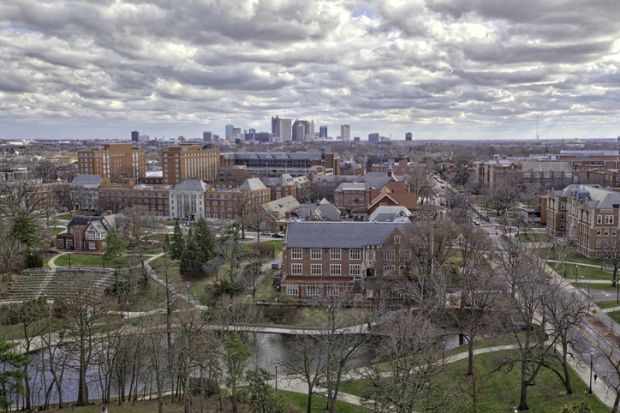Long-time residents of Columbus, Ohio’s University District perpetuate the myth of a middle-class homeowner’s lost golden age that was destroyed by a sudden incursion of rowdy undergraduates.
That golden age never existed, but there is certainly truth to the claim that the university’s influence on (for which read “neglect of”) its adjacent neighbourhood has not been benign. And it is a situation that is mirrored, to a greater or lesser extent, in many cities around the US and the world.
A few decades ago, too much attention was accorded to university self-promotion about transforming previously blighted neighbourhoods into high-tech districts, such as at Stanford, Penn and Georgia Tech. More recently, by contrast, uninformed “progressive” complaints about “neoliberal” institutions expanding into minority/impoverished areas have predominated – with some pushback.
On both sides, however, realities complicate the rhetorical picture. Differences and similarities between public and private, urban and non-urban universities are ignored. Columbus’s public, campus-based Ohio State University (OSU), for instance, contrasts sharpy with Pittsburgh’s urban-integrated University of Pittsburgh (public) and Carnegie Mellon University (private) 200 miles to its east. Large-scale real estate development and residential change by race and social class are only parts of the larger picture. History also matters.
Columbus offers an example of the real-world complexities. Chartered in 1870 as the principal public state university campus in Ohio under the segregationist Morrill Act, Ohio State sits on dispossessed Indigenous peoples’ land that was originally outside the city. Over time, Columbus grew to surround it, but OSU never embraced the roles and relationships of an urban and, especially, public university campus.
The adjacent, almost completely private residential University District grew symbiotically but without any formal input from the university – apart from when the university “annexed” some property and closed streets in the 1980 and 1990s to build dormitories. The district always housed by far the greatest number of students, but into the 1980s it also was home to a great many faculty and staff. Students lived in spare rooms in many large private houses, including faculty homes, as the owners’ children left. The city charter stipulated that no more than five unrelated persons were permitted to rent rooms in the same building.
Since the 1980s, however, private lobbying, campaign contributions and under-the-table payments to city zoning inspectors, department heads, city councillors and mayors has allowed vested interests to make huge amounts of money out of students by disregarding history, homeowners’ wishes and even the law – all with precious little pushback from the university.
Large property owners and managers now lease thousands of properties, housing tens of thousands of students. Single-family homes whose former owners have retired or passed away are converted into accommodation for up to 20 students and attract the worse-behaved, allergic to the minimal regulations imposed on fraternity houses in the 2010s in the wake of hazing and rape scandals.
In a push-and-pull relationship, families with younger children moved to more suburban areas with fewer drunks and crime, and better schools. Many of those property owners, ironically, themselves became landlords, good, bad and indifferent. Today, historic churches with shrinking congregations are moving out, too.
The largest landlords are well known for cheating tenants on their damage deposits, utility bills and legally mandated upkeep. Yet, despite its rhetoric to the contrary, the university does little to address the situation. It doesn’t build more on-campus housing. It doesn’t advise students of their tenants’ rights or provide information on landlords. It doesn’t patrol the area. And it doesn’t buy up property itself – as remaining homeowners, including myself, have long proposed – to create themed residential houses (examples of which range from traditional religious-based residences, through accommodation for people studying certain professional fields or involved in social and cultural activisms, to residences for former teenage golf caddies on scholarship aid).
The university does, however, accept donations from large private landlords, including the one ranking lowest in the university’s own student surveys; the OSU website even appears to suggest that the firm, which is the subject of numerous complaints and lawsuits, is an official housing provider.
Meanwhile, articulating the well-worn script about “saving” a dangerous, dying neighbourhood, the university has facilitated new six-storey developments around the campus that have involved the removal of many existing residents and the destruction of longstanding, often-beloved landmark restaurants, bars, clubs and shops, frequented by generations of students. A small scheme to buy properties near campus to resell to faculty or staff has had little impact.
The University District is an abandoned orphan in an aspiring metropolis, in the shadows of an overly large, disorganised mega-versity. A public university, in particular, can surely be expected to do much better.
There are, of course, examples of higher education institutions that do much more to improve town-gown relationships. Examples include the University of Minnesota in the Twin Cities of Minneapolis-St. Paul, the University of Pennsylvania and Johns Hopkins University.
But too many others wash their hands of responsibility for their surrounding neighbourhoods – even as their expansion in student enrolments far outstrips their capacity to house those students on campus. Rhetoric about civic responsibility is not nearly enough. Universities’ responsibilities begin with the welfare of their own neighbours and students. Chasing global excellence, whatever that means, comes a distant second.
Harvey J. Graff is professor emeritus of English and history at The Ohio State University and inaugural Ohio eminent scholar in literacy studies. His latest book My Life with Literacy: The Continuing Education of a Historian. The Intersections of the Personal, the Political, the Academic, and Place is forthcoming.
Register to continue
Why register?
- Registration is free and only takes a moment
- Once registered, you can read 3 articles a month
- Sign up for our newsletter
Subscribe
Or subscribe for unlimited access to:
- Unlimited access to news, views, insights & reviews
- Digital editions
- Digital access to THE’s university and college rankings analysis
Already registered or a current subscriber? Login








